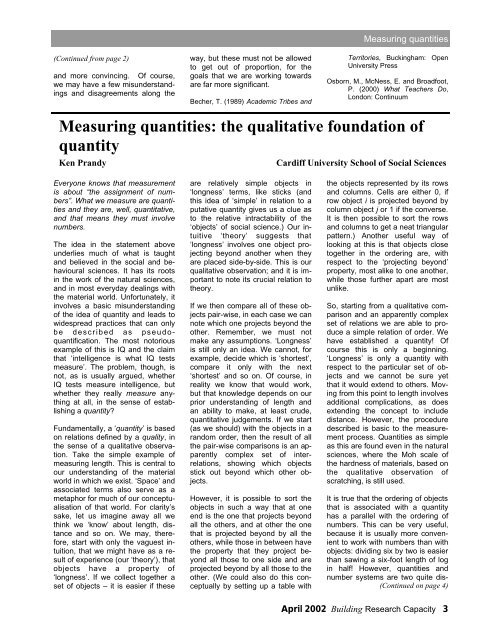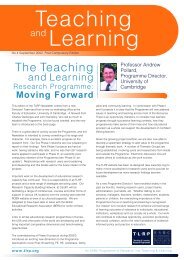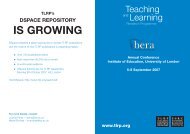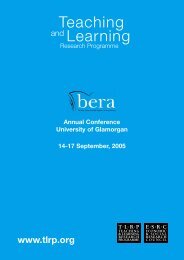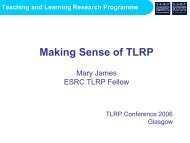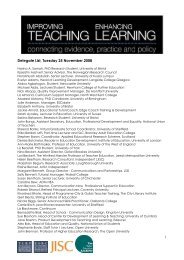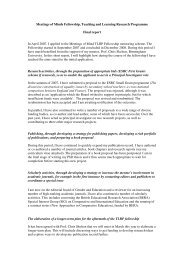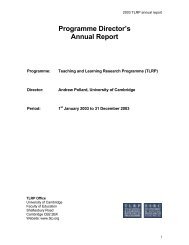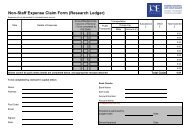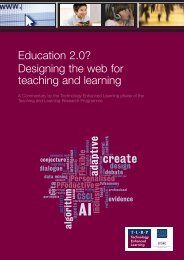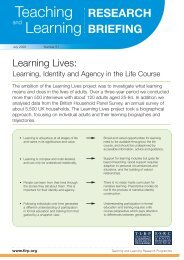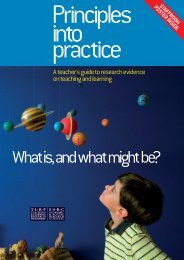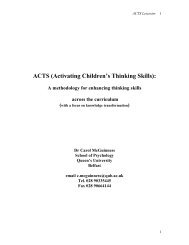Issue 2: the qualitative foundation of quantity - Teaching and ...
Issue 2: the qualitative foundation of quantity - Teaching and ...
Issue 2: the qualitative foundation of quantity - Teaching and ...
Create successful ePaper yourself
Turn your PDF publications into a flip-book with our unique Google optimized e-Paper software.
(Continued from page 2)<br />
<strong>and</strong> more convincing. Of course,<br />
we may have a few misunderst<strong>and</strong>ings<br />
<strong>and</strong> disagreements along <strong>the</strong><br />
way, but <strong>the</strong>se must not be allowed<br />
to get out <strong>of</strong> proportion, for <strong>the</strong><br />
goals that we are working towards<br />
are far more significant.<br />
Becher, T. (1989) Academic Tribes <strong>and</strong><br />
Measuring quantities<br />
Territories, Buckingham: Open<br />
University Press<br />
Osborn, M., McNess, E. <strong>and</strong> Broadfoot,<br />
P. (2000) What Teachers Do,<br />
London: Continuum<br />
Measuring quantities: <strong>the</strong> <strong>qualitative</strong> <strong>foundation</strong> <strong>of</strong><br />
<strong>quantity</strong><br />
Ken Pr<strong>and</strong>y<br />
Cardiff University School <strong>of</strong> Social Sciences<br />
Everyone knows that measurement<br />
is about “<strong>the</strong> assignment <strong>of</strong> numbers”.<br />
What we measure are quantities<br />
<strong>and</strong> <strong>the</strong>y are, well, quantitative,<br />
<strong>and</strong> that means <strong>the</strong>y must involve<br />
numbers.<br />
The idea in <strong>the</strong> statement above<br />
underlies much <strong>of</strong> what is taught<br />
<strong>and</strong> believed in <strong>the</strong> social <strong>and</strong> behavioural<br />
sciences. It has its roots<br />
in <strong>the</strong> work <strong>of</strong> <strong>the</strong> natural sciences,<br />
<strong>and</strong> in most everyday dealings with<br />
<strong>the</strong> material world. Unfortunately, it<br />
involves a basic misunderst<strong>and</strong>ing<br />
<strong>of</strong> <strong>the</strong> idea <strong>of</strong> <strong>quantity</strong> <strong>and</strong> leads to<br />
widespread practices that can only<br />
be described as pseudoquantification.<br />
The most notorious<br />
example <strong>of</strong> this is IQ <strong>and</strong> <strong>the</strong> claim<br />
that ‘intelligence is what IQ tests<br />
measure’. The problem, though, is<br />
not, as is usually argued, whe<strong>the</strong>r<br />
IQ tests measure intelligence, but<br />
whe<strong>the</strong>r <strong>the</strong>y really measure anything<br />
at all, in <strong>the</strong> sense <strong>of</strong> establishing<br />
a <strong>quantity</strong>?<br />
Fundamentally, a ‘<strong>quantity</strong>’ is based<br />
on relations defined by a quality, in<br />
<strong>the</strong> sense <strong>of</strong> a <strong>qualitative</strong> observation.<br />
Take <strong>the</strong> simple example <strong>of</strong><br />
measuring length. This is central to<br />
our underst<strong>and</strong>ing <strong>of</strong> <strong>the</strong> material<br />
world in which we exist. ‘Space’ <strong>and</strong><br />
associated terms also serve as a<br />
metaphor for much <strong>of</strong> our conceptualisation<br />
<strong>of</strong> that world. For clarity’s<br />
sake, let us imagine away all we<br />
think we ‘know’ about length, distance<br />
<strong>and</strong> so on. We may, <strong>the</strong>refore,<br />
start with only <strong>the</strong> vaguest intuition,<br />
that we might have as a result<br />
<strong>of</strong> experience (our ‘<strong>the</strong>ory’), that<br />
objects have a property <strong>of</strong><br />
‘longness’. If we collect toge<strong>the</strong>r a<br />
set <strong>of</strong> objects – it is easier if <strong>the</strong>se<br />
are relatively simple objects in<br />
‘longness’ terms, like sticks (<strong>and</strong><br />
this idea <strong>of</strong> ‘simple’ in relation to a<br />
putative <strong>quantity</strong> gives us a clue as<br />
to <strong>the</strong> relative intractability <strong>of</strong> <strong>the</strong><br />
‘objects’ <strong>of</strong> social science.) Our intuitive<br />
‘<strong>the</strong>ory’ suggests that<br />
‘longness’ involves one object projecting<br />
beyond ano<strong>the</strong>r when <strong>the</strong>y<br />
are placed side-by-side. This is our<br />
<strong>qualitative</strong> observation; <strong>and</strong> it is important<br />
to note its crucial relation to<br />
<strong>the</strong>ory.<br />
If we <strong>the</strong>n compare all <strong>of</strong> <strong>the</strong>se objects<br />
pair-wise, in each case we can<br />
note which one projects beyond <strong>the</strong><br />
o<strong>the</strong>r. Remember, we must not<br />
make any assumptions. ‘Longness’<br />
is still only an idea. We cannot, for<br />
example, decide which is ‘shortest’,<br />
compare it only with <strong>the</strong> next<br />
‘shortest’ <strong>and</strong> so on. Of course, in<br />
reality we know that would work,<br />
but that knowledge depends on our<br />
prior underst<strong>and</strong>ing <strong>of</strong> length <strong>and</strong><br />
an ability to make, at least crude,<br />
quantitative judgements. If we start<br />
(as we should) with <strong>the</strong> objects in a<br />
r<strong>and</strong>om order, <strong>the</strong>n <strong>the</strong> result <strong>of</strong> all<br />
<strong>the</strong> pair-wise comparisons is an apparently<br />
complex set <strong>of</strong> interrelations,<br />
showing which objects<br />
stick out beyond which o<strong>the</strong>r objects.<br />
However, it is possible to sort <strong>the</strong><br />
objects in such a way that at one<br />
end is <strong>the</strong> one that projects beyond<br />
all <strong>the</strong> o<strong>the</strong>rs, <strong>and</strong> at o<strong>the</strong>r <strong>the</strong> one<br />
that is projected beyond by all <strong>the</strong><br />
o<strong>the</strong>rs, while those in between have<br />
<strong>the</strong> property that <strong>the</strong>y project beyond<br />
all those to one side <strong>and</strong> are<br />
projected beyond by all those to <strong>the</strong><br />
o<strong>the</strong>r. (We could also do this conceptually<br />
by setting up a table with<br />
<strong>the</strong> objects represented by its rows<br />
<strong>and</strong> columns. Cells are ei<strong>the</strong>r 0, if<br />
row object i is projected beyond by<br />
column object j or 1 if <strong>the</strong> converse.<br />
It is <strong>the</strong>n possible to sort <strong>the</strong> rows<br />
<strong>and</strong> columns to get a neat triangular<br />
pattern.) Ano<strong>the</strong>r useful way <strong>of</strong><br />
looking at this is that objects close<br />
toge<strong>the</strong>r in <strong>the</strong> ordering are, with<br />
respect to <strong>the</strong> ‘projecting beyond’<br />
property, most alike to one ano<strong>the</strong>r,<br />
while those fur<strong>the</strong>r apart are most<br />
unlike.<br />
So, starting from a <strong>qualitative</strong> comparison<br />
<strong>and</strong> an apparently complex<br />
set <strong>of</strong> relations we are able to produce<br />
a simple relation <strong>of</strong> order. We<br />
have established a <strong>quantity</strong>! Of<br />
course this is only a beginning.<br />
‘Longness’ is only a <strong>quantity</strong> with<br />
respect to <strong>the</strong> particular set <strong>of</strong> objects<br />
<strong>and</strong> we cannot be sure yet<br />
that it would extend to o<strong>the</strong>rs. Moving<br />
from this point to length involves<br />
additional complications, as does<br />
extending <strong>the</strong> concept to include<br />
distance. However, <strong>the</strong> procedure<br />
described is basic to <strong>the</strong> measurement<br />
process. Quantities as simple<br />
as this are found even in <strong>the</strong> natural<br />
sciences, where <strong>the</strong> Moh scale <strong>of</strong><br />
<strong>the</strong> hardness <strong>of</strong> materials, based on<br />
<strong>the</strong> <strong>qualitative</strong> observation <strong>of</strong><br />
scratching, is still used.<br />
It is true that <strong>the</strong> ordering <strong>of</strong> objects<br />
that is associated with a <strong>quantity</strong><br />
has a parallel with <strong>the</strong> ordering <strong>of</strong><br />
numbers. This can be very useful,<br />
because it is usually more convenient<br />
to work with numbers than with<br />
objects: dividing six by two is easier<br />
than sawing a six-foot length <strong>of</strong> log<br />
in half! However, quantities <strong>and</strong><br />
number systems are two quite dis-<br />
(Continued on page 4)<br />
April 2002 Building Research Capacity 3


